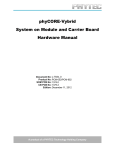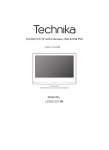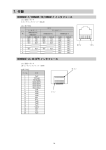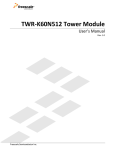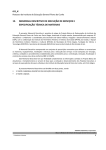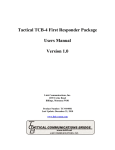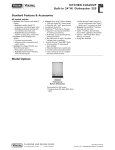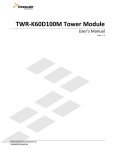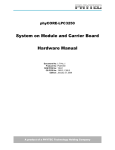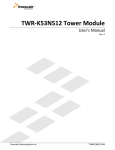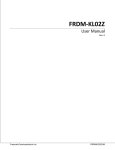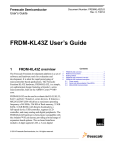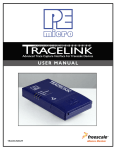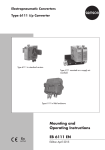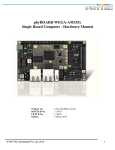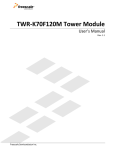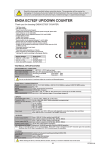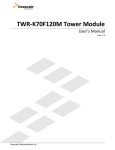Download System on Module and Carrier Board Hardware Manual Cosmic
Transcript
Cosmic Board for phyCORE-Vybrid System on Module and Carrier Board Hardware Manual Document No: L-790e_1 Product No: PCL-052/POB-001 SOM PCB No: 1395.0 CB PCB No: 1393.1 Edition: August 30, 2013 A product of a PHYTEC Technology Holding Company L-790e_1 Cosmic Board In this manual are descriptions for copyrighted products that are not explicitly indicated as such. The absence of the trademark (™) and copyright (©) symbols does not imply that a product is not protected. Additionally, registered patents and trademarks are similarly not expressly indicated in this manual. The information in this document has been carefully checked and is believed to be entirely reliable. However, PHYTEC America LLC assumes no responsibility for any inaccuracies. PHYTEC America LLC neither gives any guarantee nor accepts any liability whatsoever for consequential damages resulting from the use of this manual or its associated product. PHYTEC America LLC reserves the right to alter the information contained herein without prior notification and accepts no responsibility for any damages which might result. Additionally, PHYTEC America LLC offers no guarantee nor accepts any liability for damages arising from the improper usage or improper installation of the hardware or software. PHYTEC America LLC further reserves the right to alter the layout and/or design of the hardware without prior notification and accepts no liability for doing so. © Copyright 2011 PHYTEC America LLC, Bainbridge Island, WA. Rights - including those of translation, reprint, broadcast, photomechanical or similar reproduction and storage or processing in computer systems, in whole or in part - are reserved. No reproduction may occur without the express written consent from PHYTEC America LLC. EUROPE NORTH AMERICA PHYTEC Technologie Holding AG Robert-Koch-Str. 39 D-55129 Mainz GERMANY PHYTEC America LLC 203 Parfitt Way SW, Suite G100 Bainbridge Island, WA 98110 USA +49 (800) 0749832 [email protected] 1 (800) 278-9913 [email protected] Technical Support: +49 (6131) 9221-31 [email protected] 1 (800) 278-9913 [email protected] Fax: +49 (6131) 9221-33 1 (206) 780-9135 http://www.phytec.eu http://www.phytec.de http://www.phytec.com Address: Ordering Information: Website: © PHYTEC America LLC 2013 L-790e_1 Table of Contents L-790e_1 Table of Contents List of Tables. . . . . . . . . . . . . . . . . . . . . . . . . . . . . . . . . . . . . . . . . . . . . . . . . . . . . . . . . . ii List of Figures . . . . . . . . . . . . . . . . . . . . . . . . . . . . . . . . . . . . . . . . . . . . . . . . . . . . . . . . .iii Conventions, Abbreviations, and Acronyms . . . . . . . . . . . . . . . . . . . . . . . . . . . . . . . . . . . . . . . . . . . . iv 1 Introduction . . . . . . . . . . . . . . . . . . . . . . . . . . . . . . . . . . . . . . . . . . . . . . . . . . . . . . . . . . . . . . . . . . . . . . . 1 1.1 Cosmic Board Features . . . . . . . . . . . . . . . . . . . . . . . . . . . . . . . . . . . . . . . . . . . . . . . . . . . . . . 2 1.2 Block Diagram . . . . . . . . . . . . . . . . . . . . . . . . . . . . . . . . . . . . . . . . . . . . . . . . . . . . . . . . . . . . . 2 2 PCL-052/phyCORE-Vybrid System on Module . . . . . . . . . . . . . . . . . . . . . . . . . . . . . . . . . . . . . . . . . . . . 3 2.1 phyCORE-Vybrid Features . . . . . . . . . . . . . . . . . . . . . . . . . . . . . . . . . . . . . . . . . . . . . . . . . . . 3 3 Power . . . . . . . . . . . . . . . . . . . . . . . . . . . . . . . . . . . . . . . . . . . . . . . . . . . . . . . . . . . . . . . . . . . . . . . . . . . 5 3.1 Jumper Settings (JP1) . . . . . . . . . . . . . . . . . . . . . . . . . . . . . . . . . . . . . . . . . . . . . . . . . . . . . . . 5 3.2 USB Power (X6) . . . . . . . . . . . . . . . . . . . . . . . . . . . . . . . . . . . . . . . . . . . . . . . . . . . . . . . . . . . 5 3.3 Wall Power (X2). . . . . . . . . . . . . . . . . . . . . . . . . . . . . . . . . . . . . . . . . . . . . . . . . . . . . . . . . . . . 5 4 Ethernet (X3) . . . . . . . . . . . . . . . . . . . . . . . . . . . . . . . . . . . . . . . . . . . . . . . . . . . . . . . . . . . . . . . . . . . . . . 6 5 RS-232 Console (X10) . . . . . . . . . . . . . . . . . . . . . . . . . . . . . . . . . . . . . . . . . . . . . . . . . . . . . . . . . . . . . . 7 6 USB Connectivity. . . . . . . . . . . . . . . . . . . . . . . . . . . . . . . . . . . . . . . . . . . . . . . . . . . . . . . . . . . . . . . . . . . 8 6.1 USB Host (X3) . . . . . . . . . . . . . . . . . . . . . . . . . . . . . . . . . . . . . . . . . . . . . . . . . . . . . . . . . . . . . 8 6.2 USB OTG (X6). . . . . . . . . . . . . . . . . . . . . . . . . . . . . . . . . . . . . . . . . . . . . . . . . . . . . . . . . . . . . 8 7 SD Card (X18) . . . . . . . . . . . . . . . . . . . . . . . . . . . . . . . . . . . . . . . . . . . . . . . . . . . . . . . . . . . . . . . . . . . . . 9 7.1 Inserting and Removing an SD Card . . . . . . . . . . . . . . . . . . . . . . . . . . . . . . . . . . . . . . . . . . . . 9 8 HDMI (X16) . . . . . . . . . . . . . . . . . . . . . . . . . . . . . . . . . . . . . . . . . . . . . . . . . . . . . . . . . . . . . . . . . . . . . . 10 9 User Buttons . . . . . . . . . . . . . . . . . . . . . . . . . . . . . . . . . . . . . . . . . . . . . . . . . . . . . . . . . . . . . . . . . . . . . 11 10 System Reset Button (S5) . . . . . . . . . . . . . . . . . . . . . . . . . . . . . . . . . . . . . . . . . . . . . . . . . . . . . . . . . . 12 11 User LEDs . . . . . . . . . . . . . . . . . . . . . . . . . . . . . . . . . . . . . . . . . . . . . . . . . . . . . . . . . . . . . . . . . . . . . . 13 12 Boot Selection (JP2) . . . . . . . . . . . . . . . . . . . . . . . . . . . . . . . . . . . . . . . . . . . . . . . . . . . . . . . . . . . . . . 14 13 Expansion Connectors (X19, X20) . . . . . . . . . . . . . . . . . . . . . . . . . . . . . . . . . . . . . . . . . . . . . . . . . . . 15 14 OpenSDA Debug. . . . . . . . . . . . . . . . . . . . . . . . . . . . . . . . . . . . . . . . . . . . . . . . . . . . . . . . . . . . . . . . . 21 15 Technical Specifications . . . . . . . . . . . . . . . . . . . . . . . . . . . . . . . . . . . . . . . . . . . . . . . . . . . . . . . . . . . 22 16 Component Placement Diagrams . . . . . . . . . . . . . . . . . . . . . . . . . . . . . . . . . . . . . . . . . . . . . . . . . . . . 24 Revision History . . . . . . . . . . . . . . . . . . . . . . . . . . . . . . . . . . . . . . . . . . . . . . . . . . . . . . . . . . . . . . . . . . . 26 © PHYTEC America LLC 2013 i List of Tables L-790e_1 List of Tables Table i-1. Abbreviations and Acronyms Used in This Manual . . . . . . . . . . . . . . . . . . . . . . . . . . . . iv Table i-2. Types of Signals . . . . . . . . . . . . . . . . . . . . . . . . . . . . . . . . . . . . . . . . . . . . . . . . . . . . . . v Table 3-1. Jumper Settings (JP1) . . . . . . . . . . . . . . . . . . . . . . . . . . . . . . . . . . . . . . . . . . . . . . . . . 5 Table 5-1. Connector X10 Pin Descriptions . . . . . . . . . . . . . . . . . . . . . . . . . . . . . . . . . . . . . . . . . 7 Table 12-1. Jumper Settings and Descriptions . . . . . . . . . . . . . . . . . . . . . . . . . . . . . . . . . . . . . . 14 Table 13-1. Power Signal Map . . . . . . . . . . . . . . . . . . . . . . . . . . . . . . . . . . . . . . . . . . . . . . . . . . 15 Table 13-2. System Signal Map . . . . . . . . . . . . . . . . . . . . . . . . . . . . . . . . . . . . . . . . . . . . . . . . . 15 Table 13-3. JTAG Signal Map . . . . . . . . . . . . . . . . . . . . . . . . . . . . . . . . . . . . . . . . . . . . . . . . . . . 15 Table 13-4. CAN Signal Map . . . . . . . . . . . . . . . . . . . . . . . . . . . . . . . . . . . . . . . . . . . . . . . . . . . . 16 Table 13-5. I2C Signal Map . . . . . . . . . . . . . . . . . . . . . . . . . . . . . . . . . . . . . . . . . . . . . . . . . . . . . 16 Table 13-6. UART Signal Map . . . . . . . . . . . . . . . . . . . . . . . . . . . . . . . . . . . . . . . . . . . . . . . . . . . 16 Table 13-8. ADC Signal Map . . . . . . . . . . . . . . . . . . . . . . . . . . . . . . . . . . . . . . . . . . . . . . . . . . . . 17 Table 13-9. DAC Signal Map . . . . . . . . . . . . . . . . . . . . . . . . . . . . . . . . . . . . . . . . . . . . . . . . . . . . 17 Table 13-7. QSPI Signal Map . . . . . . . . . . . . . . . . . . . . . . . . . . . . . . . . . . . . . . . . . . . . . . . . . . . 17 Table 13-10. SDHC Signal Map . . . . . . . . . . . . . . . . . . . . . . . . . . . . . . . . . . . . . . . . . . . . . . . . . 18 Table 13-11. LCD Signal Map . . . . . . . . . . . . . . . . . . . . . . . . . . . . . . . . . . . . . . . . . . . . . . . . . . . 18 Table 13-12. FlexBus Signal Map . . . . . . . . . . . . . . . . . . . . . . . . . . . . . . . . . . . . . . . . . . . . . . . . 19 Table 13-13. Miscellaneous Signal Map . . . . . . . . . . . . . . . . . . . . . . . . . . . . . . . . . . . . . . . . . . . 20 Table 15-1. Technical Specifications . . . . . . . . . . . . . . . . . . . . . . . . . . . . . . . . . . . . . . . . . . . . . . 23 Table 17-1. Revision History . . . . . . . . . . . . . . . . . . . . . . . . . . . . . . . . . . . . . . . . . . . . . . . . . . . . 26 © PHYTEC America LLC 2013 ii List of Figures L-790e_1 List of Figures Fig. 1-1. Cosmic Board. . . . . . . . . . . . . . . . . . . . . . . . . . . . . . . . . . . . . . . . . . . . . . . . . . . . . . . . . . 1 Fig. 1-2. Cosmic Board Block Diagram . . . . . . . . . . . . . . . . . . . . . . . . . . . . . . . . . . . . . . . . . . . . . 2 Fig. 5-1. RS-232 Connector X10 Pin Numbering . . . . . . . . . . . . . . . . . . . . . . . . . . . . . . . . . . . . . . 7 Fig. 12-1. Jumper Numbering Scheme . . . . . . . . . . . . . . . . . . . . . . . . . . . . . . . . . . . . . . . . . . . . 14 Fig. 15-1. Cosmic Board Physical Dimensions. . . . . . . . . . . . . . . . . . . . . . . . . . . . . . . . . . . . . . . 22 Fig. 16-1. Cosmic Board Top . . . . . . . . . . . . . . . . . . . . . . . . . . . . . . . . . . . . . . . . . . . . . . . . . . . . 24 Fig. 16-2. Cosmic Board Bottom . . . . . . . . . . . . . . . . . . . . . . . . . . . . . . . . . . . . . . . . . . . . . . . . . 25 © PHYTEC America LLC 2013 iii L-790e_1 Conventions, Abbreviations, and Acronyms Conventions The conventions used in this manual are as follows: • Signals that are preceded by a “/” character are designated as active low signals. Their active state is when they are driven low, or are driving low; for example: /RESET. • Tables show the default setting or jumper position in bold, teal text. • Text in blue indicates a hyperlink, either internal or external to the document. Click these links to quickly jump to the applicable URL, part, chapter, table, or figure. • References made to the phyCORE-Connector always refer to the high density Samtec connectors on the underside of the Cosmic Board System on Module. Abbreviations and Acronyms Many acronyms and abbreviations are used throughout this manual. Use the table below to navigate unfamiliar terms used in this document. Table i-1. Abbreviations and Acronyms Used in This Manual Abbreviation Definition BSP Board Support Package (Software delivered with the Development Kit including an operating system (Windows or Linux) preinstalled on the module and Development Tools). CB Carrier Board; used in reference to the PCM-952/Cosmic Board Carrier Board DFF D flip-flop EMB External memory bus EMI Electromagnetic Interference GPI General purpose input GPIO General purpose input and output GPO General purpose output IRAM Internal RAM; the internal static RAM on the Freescale VFx00 processor J Solder jumper; these types of jumpers require solder equipment to remove and place JP Solderless jumper; these types of jumpers can be removed and placed by hand with no special tools PCB Printed circuit board PDI PHYTEC Display Interface; defined to connect PHYTEC display adapter boards or custom adapters PEB PHYTEC Extension Board PMIC Power Management Integrated Circuit PoE Power over Ethernet PoP Package on Package PoR Power-on reset RTC Real-time clock SMT Surface mount technology © PHYTEC America LLC 2013 iv L-790e_1 Table i-1. Abbreviations and Acronyms Used in This Manual Abbreviation Definition SOM System on Module; used in reference to the PCM-052/Cosmic Board System on Module Sx User button Sx (S1, S2, etc.) used in reference to the available user buttons, or DIP switches on the Carrier Board Sx_y Switch y of DIP switch Sx; used in reference to the DIP switch on the Carrier Board TRM Technical Reference Manual VBAT SOM battery supply input Different types of signals are brought out at the phyCORE-Connector. The following table lists the abbreviations used to specify the type of a signal. Table i-2. Types of Signals Type of Signal Description Abbreviation Power Supply voltage PWR Ref-Voltage Reference voltage REF USB-Power USB voltage USB Input Digital input IN Output Digital output OUT Input with pull-up Input with pull-up (jumper or open-collector output) IPU Input/output Bidirectional input/output IO 5V Input with pull-down 5V tolerant input with pull-down 5V_PD LVDS Differential line pairs 100 Ohm LVDS Pegel LVDS Differential 90 Ohm Differential line pairs 90 Ohm DIFF90 Differential 100 Ohm Differential line pairs 100 Ohm DIFF100 Analog Analog input or output Analog © PHYTEC America LLC 2013 v L-790e_1 Preface This Cosmic Board Hardware Manual describes the System on Module's design and functions. Precise specifications for the Freescale VFx00 processor can be found in the processor datasheet and/or user's manual. In this hardware manual and in the schematics, active low signals are denoted by a "/" preceding the signal name, for example: /RD. A "0" represents a logic-zero or low-level signal, while a "1" represents a logicone or high-level signal. Declaration of Electro Magnetic Conformity of the PHYTEC Cosmic Board PHYTEC System on Modules (SOMs) are designed for installation in electrical appliances or, combined with the PHYTEC Carrier Board, can be used as dedicated Evaluation Boards (for use as a test and prototype platform for hardware/software development) in laboratory environments. CAUTION: PHYTEC products lacking protective enclosures are subject to damage by ESD and, hence, may only be unpacked, handled or operated in environments in which sufficient precautionary measures have been taken in respect to ESD-dangers. It is also necessary that only appropriately trained personnel (such as electricians, technicians and engineers) handle and/or operate these products. Moreover, PHYTEC products should not be operated without protection circuitry if connections to the product's pin header rows are longer than 3 m. PHYTEC products fulfill the norms of the European Union's Directive for Electro Magnetic Conformity only in accordance to the descriptions and rules of usage indicated in this hardware manual (particularly in respect to the pin header row connectors, power connector and serial interface to a host-PC). Implementation of PHYTEC products into target devices, as well as user modifications and extensions of PHYTEC products, is subject to renewed establishment of conformity to, and certification of, Electro Magnetic Directives. Users should ensure conformance following any modifications to the products as well as implementation of the products into target systems. The Cosmic Board is one of a series of PHYTEC System on Modules that can be populated with different controllers and, hence, offers various functions and configurations. PHYTEC supports a variety of 8-/16and 32-bit controllers in two ways: 1. As the basis for Rapid Development Kits which serve as a reference and evaluation platform. 2. As insert-ready, fully functional phyCORE OEM modules, which can be embedded directly into the user's peripheral hardware design. Implementation of an OEM-able SOM subassembly as the "core" of your embedded design allows you to focus on hardware peripherals and firmware without expending resources to "re-invent" microcontroller circuitry. Furthermore, much of the value of the phyCORE module lies in its layout and test. Production-ready Board Support Packages (BSPs) and Design Services for our hardware further reduce development time and expenses. Take advantage of PHYTEC products to shorten time-to-market, reduce development costs, and avoid substantial design issues and risks. For more information go to: http://www.phytec.com/services/design-services/index.html © PHYTEC America LLC 2013 vi L-790e_1 Product Change Management In addition to our HW and SW offerings, the buyer will receive a free obsolescence maintenance service for the HW provided when purchasing a PHYTEC SOM. Our Product Change Management Team of developers is continuously processing all incoming PCN's (Product Change Notifications) from vendors and distributors concerning parts which are being used in our products. Possible impacts to the functionality of our products, due to changes of functionality or obsolesce of a certain part, are evaluated in order to take the right measures in purchasing or within our HW/SW design. Our general philosophy here is: We never discontinue a product as long as there is demand for it. Therefore a set of methods has been established to fulfill our philosophy: Avoidance strategies • Avoid changes by evaluating longevity of a parts during design-in phase. • Ensure availability of equivalent second source parts. • Maintain close contact with part vendors for awareness of roadmap strategies. Change management in case of functional changes • Avoid impacts on Product functionality by choosing equivalent replacement parts. • Avoid impacts on Product functionality by compensating changes through HW redesign or backward compatibility SW maintenance • Provide early change notifications concerning functional relevant changes of our Products. Change management in rare event of an obsolete and non replaceable part • Ensure long term availability by stocking parts through last time buy management, according to product forecasts. • Offer long term frame contract to customers. We refrain from providing detailed, part-specific information within this manual, which is subject to changes, due to ongoing part maintenance for our products. © PHYTEC America LLC 2013 vii Chapter 1: Introduction L-790e_1 1 Introduction Fig. 1-1. Cosmic Board The Cosmic Board for phyCORE-Vybrid is a low-cost, feature-rich software development platform supporting the FreescaleTM Vybrid VF5xx and VF6xx processor families. At the core of the Cosmic board is the PCL-052/phyCORE-Vybrid System On Module (SOM) in a direct solder form factor, containing the processor, DRAM, NAND Flash, power regulation, supervision, transceivers, and other core functions required to support the Vybrid processor. Surrounding the SOM is the POB-001/Cosmic Carrier Board, adding power input, buttons, connectors, signal breakout, and HDMI connectivity amongst other things. The PCL-052 System On Module is a connector-less, BGA style variant of the PCM-052/phyCORE-Vybrid SOM. Unlike traditional PHYTEC SOM products that support high density connectors, the PCL-052 SOM is directly soldered down to its Carrier Board using PHYTEC's Direct Solder Connect technology. This solution offers an ultra-low cost Single Board Computer for the Vybrid processor, while maintaining most of the advantages of the SOM concept. Adding the phyCORE-Vybrid SOM into your own design is as simple as ordering the connectored version (PCM-052) and making use of our Cosmic Carrier Board (POB-001), or RDK Carrier Board (PCM-952) reference schematics. A summary of the Cosmic Board features, along with a block diagram are presented below. © PHYTEC America LLC 2013 1 Chapter 1: Introduction L-790e_1 1.1 Cosmic Board Features • • • • • • • • • • • • • phyCORE-Vybrid System On Module Board power over: - USB OTG Connector - Wall Adapter Input High Speed USB Host Connector (standard A) High Speed USB OTG Connector (micro AB) 10/100 Ethernet RJ-45 Jack Micro SD Card Slot Micro HDMI connector supporting 640x480 @ 24bpp RS-232 Console Connectivity via DB-9 Boot Selection Jumpers (NAND or SD Card) Hardware Debug via OpenSDA over USB (Cosmic+ kit only) 4x User Buttons 4x User LEDs 120-pin, 2mm header socket for easy access to Vybrid processor signals 1.2 Block Diagram Fig. 1-2. Cosmic Board Block Diagram © PHYTEC America LLC 2013 2 Chapter 2: PCL-052/phyCORE-Vybrid System on Module L-790e_1 2 PCL-052/phyCORE-Vybrid System on Module This chapter gives a brief introduction to the PCL-052/phyCORE-Vybrid System on Module (SOM), highlighting its benefits and features. For more detailed information, please refer to the Hardware Manual for the modular, connectored version of the SOM (PCM-052) by clicking here. The phyCORE-Vybrid belongs to PHYTEC’s phyCORE System on Module (SOM) family. The phyCORE SOMs represent the continuous development of PHYTEC SOM technology. Like its mini-, micro-, and nanoMODUL predecessors, the phyCORE boards integrate all core elements of a microcontroller system on a subminiature board and are designed in a manner that ensures their easy expansion and embedding in peripheral hardware developments. As independent research indicates that approximately 70% of all EMI (Electro Magnetic Interference) problems stem from insufficient supply voltage grounding of electronic components in high frequency environments, the phyCORE board design features an increased pin package. The increased pin package allows dedication of approximately 20% of all connector pins on the phyCORE boards to ground. This improves EMI and EMC characteristics and makes it easier to design complex applications meeting EMI and EMC guidelines using phyCORE boards even in high noise environments. phyCORE boards achieve their small size through modern SMD technology and multi-layer design. In accordance with the complexity of the module, 0402-packaged SMD components and laser-drilled Microvias are used on the boards, providing phyCORE users with access to this cutting edge miniaturization technology for integration into their own design. The PCM-052, connectored version of the phyCORE-Vybrid is a sub-miniature (41 x 51 mm) insert-ready SOM populated with Freescale FVx00 processor. Its universal design enables its insertion into a wide range of embedded applications. All processor signals and ports extend from the processor to high-density pitch (0.5 mm) connectors aligning two sides of the board. This allows the SOM to be plugged like a "big chip" into a target application. The PCL-052, connectorless version of the phyCORE-Vybrid populating the Cosmic Board is identical to the connectored version, with the exception of the connection interface. Instead of two high density connectors aligning the edges of the board, the PCL-052 solders directly down to its Carrier Board with a BGA style footprint. Precise specifications for the processor populating the board can be found in the applicable processor user's manual and datasheet. The descriptions in this manual are based on the Freescale FVx00 processor. No description of compatible processor derivative functions is included, as such functions are not relevant for the basic functioning of the Cosmic Board. 2.1 phyCORE-Vybrid Features • • • • • • • Insert-ready, sub-miniature (41 mm x 51 mm) System on Module (SOM) subassembly in low EMI design, achieved through advanced SMD technology Populated with the Freescale FVx00 Single (Cortex-A5) or heterogenous Dual Core (Cortex-A5 and Cortex-M4) processor Max. 500 MHz core clock frequency for the Cortex-A5, 167 MHz for the Cortex-M4 Boot from NAND Flash or SPI Flash Controller signals and ports extend to two BGA-style connection interfaces aligning two sides of the board, enabling it to be soldered directly into the target application Single supply voltage of 3.3 V (max.1 A) All controller required supplies generated on board © PHYTEC America LLC 2013 3 Chapter 2: PCL-052/phyCORE-Vybrid System on Module • • • • • • • • • • • • • • • • • • • • • • • L-790e_1 Improved interference safety achieved through multi-layer PCB technology and dedicated ground pins 256 MB (up to 2 GB) on-board NAND Flash1 128/256/512 MB DDR3 SDRAM 1 4 kB (up to 32 kB) I2C EEPROM1 32 MB (up to 128 MB) SPI Flash Two RS-232 two-signal (Tx/Rx) serial interfaces, or one RS-232 interface with hardware flow control, configured through software Six UARTs Dual USB OTG 2.0 High-Speed Controller with PHY Two 10/100 MBit Ethernet interfaces with internal L2-Switch and IEEE1588 PTP for Realtime Ethernet (available as RMII TTL signals or 10/100 differential pairs) Four I2C interfaces with SMBUS support Four Serial Peripheral Interfaces (SPI) Two Quad SPI (QSPI) supporting XIP Two FlexCAN interfaces with transceivers Display interface with 24 data bits I2S audio Two 12-bit digital to analog converter (DAC) outputs Two 10-channel, 12-bit analog to digital (ADC) inputs JTAG 16-bit Trace port Two active and two passive tamper security signals 4-bit Secure Digital Host interface (SD/MMC) Real-Time Clock -40 to 85 C operating temperature range 1. The maximum memory size listed is as of the printing of this manual. Please contact PHYTEC for more information about additional, or new module configurations available. © PHYTEC America LLC 2013 4 Chapter 3: Power L-790e_1 3 Power Power is supplied to the system using two methods: 1. USB power via connector X6 2. Wall power via connector X2 USB power provides an easy, single-cable solution for both power and console connectivity. System functionality is limited when powering the board off of USB. Most features of the board will function under USB power, with the exception of USB host and any add-on boards connected via the Expansion Connectors. Select the power option by configuring jumper JP1 using Table 3-1 below. 3.1 Jumper Settings (JP1) Table 3-1. Jumper Settings (JP1) Jumper Position Description 1+2 Wall Power 2+3 USB Power See Figure 1-1 for the location of jumper JP1. Pin 1 is marked on the PCB with a clipped corner on the component outline silk screen. 3.2 USB Power (X6) USB power can be used if the USB host interface is not required, nor any add-on boards connected to the Expansion Connectors (X19, X20) are required. Use a standard USB-A to micro-AB, or micro-B connected to a PC to power the board and provide console access. A wall-outlet charger can be used to power the board but will eliminate the use of serial over USB. Configure the board for USB power by setting JP1 to 2+3. See Figure 1-1 for the location of jumper JP1. 3.3 Wall Power (X2) Wall power should be used when USB host, or expansion connector add-on boards are used. Both scenarios draw additional power not available through the USB OTG connector at X6. A suitable +5VDC +- 5% / 1A or greater wall power adapter should be used with a center positive contact. An appropriate power supply can be ordered with the kit at the time you place your order. Configure the board for wall power by setting JP1 to 1+2. See Figure 1-1 for the location of jumper JP1. CAUTION: Do not use a laboratory adapter to supply power to the Carrier Board! Power spikes during power-on could destroy the phyCORE module mounted on the Carrier Board. Do not change jumper settings while the Carrier Board is supplied with power. © PHYTEC America LLC 2013 5 Chapter 4: Ethernet (X3) L-790e_1 4 Ethernet (X3) The 10/100 ETH1 interface, derived from the Vybrid processor RMII1 signals, is accessible at an RJ-45 connector at X3 (USB Dual Standard A and Ethernet). LEDs are integrated on the connector for indication of LINK (green) and SPEED (yellow). The Ethernet PHY on the SOM supports the HP Auto-MDIX function, eliminating the need for considerations of a direct connect LAN cable or cross-over patch cable. The transceivers detect the TX and RX signals of the connected devices and automatically configure their RX and TX pins accordingly. © PHYTEC America LLC 2013 6 Chapter 5: RS-232 Console (X10) L-790e_1 5 RS-232 Console (X10) The DB9 connector X10 provides connectivity to the Vybrid SCI1 (UART) signals at RS-232 level. This interface does not include the Vybrid's SCI1_RTS and SCI1_CTS signals for flow control. This connection is provided primarily for console access, but could be reconfigured for other purposes if needed. A standard straight-through serial cable connected to a PC is required to access this console port. This port has the benefit of providing access to U-Boot and to early Linux boot log message, as opposed to the console access provided over the USB port, which provides neither. Use appropriate serial communications software such as minicom for Linux, or putty for Windows. Configure the port for 115200,8,N,1 (8 data bits, no handshake, 1 stop bit). Figure 5-1 shows the pin numbering for the DB9 connector, while Table 5-1 gives a detailed description of the signals at X10. Fig. 5-1. RS-232 Connector X10 Pin Numbering Table 5-1. Connector X10 Pin Descriptions Pin Signal I/O Description 1 N/C - Not connected 2 SCI1_TX_RS232 O SCI1 transmit 3 SCI1_RX_RS232 I SCI1 receive 4 N/C - Not connected 5 GND - GND 6 N/C - Not connected 7 N/C - Not connected 8 N/C - Not connected 9 N/C - Not connected © PHYTEC America LLC 2013 7 Chapter 6: USB Connectivity L-790e_1 6 USB Connectivity 6.1 USB Host (X3) The USB1 interface signals route to the bottom connector of X3 (USB Dual Standard A and Ethernet). Note that the top USB connector of X3 is a not used. Although the USB interface of the Vybrid processor complies with USB 2.0 HS specification and supports dual role device configuration, due to its USB-A style connector, USB1 is limited to Host operation only. The USB1 interface on the Cosmic board is equipped with ESD protection. It has its own 5V supply that is current limited by U4 (TPS2051B). It supports connection of different USB devices such as mass storage device, keyboard, and mouse. To use the USB Host interface the board must be configured to provide power from the wall adapter input at X2 (see Figure 1-1). Set jumper JP1 to 1+2 to configure the board for wall power. 6.2 USB OTG (X6) The USB0 interface signals route to connector X6 (USB Micro-AB). The USB interface of the Vybrid processor complies with USB 2.0 HS specification. Firmware interaction configures the interface to act in Host or Device mode, making it a dual role device but not a true OTG controller as described in more detail in the Vybrid processor Reference Manual. The USB0 interface on the Cosmic board is equipped with ESD protection. VBUS_USB0 is connected to VBUS of the cable meaning USB0 is powered by the host. This interface can be used both to power the board, and to provide serial console access. Connect a USB Standard-A to Micro-B, or Micro-AB cable between a host PC and connector X6. To configure the board for USB power, set jumper JP1 to 2+3 (see Figure 1-1). Once booted, the Cosmic Board shows up as a virtual serial port over USB. Use appropriate serial communications software such as minicom for Linux, or putty for Windows. Configure the port for 115200,8,N,1 (8 data bits, no handshake, 1 stop bit). © PHYTEC America LLC 2013 8 Chapter 7: SD Card (X18) L-790e_1 7 SD Card (X18) The Cosmic board provides a Micro SD card slot at X18 for connection to the Vybrid's SDHC1 interface. The interface is powered by an instant-on 3.3 V power supply and has card detect support (CDET) via the Vybrid processor PTB28 signal. In addition to mass storage usage, the processor can boot from this interface. As the default boot mode of the phyCORE-Vybrid SOM, SD boot is selected by opening JP2 (see Figure 1-1). 7.1 Inserting and Removing an SD Card Insert a micro SD Card into slot X18, label down and pins facing up. After aligning the card with the connector, push to insert. The card will make a clicking sound and latch into the connector. To eject the card, push the card in to release. The connector will click and the card will be safe to remove. To avoid damaging the connector do not attempt to pull the card directly out without first pushing inward to release the lock mechanism. © PHYTEC America LLC 2013 9 Chapter 8: HDMI (X16) L-790e_1 8 HDMI (X16) A High-Definition Multimedia Interface (HDMI) transmitter is connected to the parallel display interface of the processor. The interface is compliant with HDMI 1.4a specification and available through the micro HDMI connector at X16. Connection to an HDMI display is limited to 640x480 @ 24bpp due to Vybrid processor limitations and compatible display clock frequency limitations. The 24-bit Vybrid LCD interface (3 x 8-bit RGB) along with the I2S-bus are converted to HDMI signals by the HDMI transmitter at U1. The transmitter is configured by the processor via I2C and although operating at 1.8V, can handle the 3.3V processor signals. Along with delivering Consumer Electronic Control (CEC) the device also supports a low power or standby mode when HDMI is not being used. A port protection and interface device at U13 provides ESD protection, integrated level shifting of HDMI signals, and a 50 mA / 5V current-limited supply to the HDMI sink device (monitor, TV, projector, etc). For access to the HDMI output, a micro HDMI cable is required. For connection to general HDMI compliant devices, an HDMI to Micro HDMI cable will typical be used. The display signals that are connected to the HDMI interface (PTE0 to PTE28) are available at the expansion connector so that they can be used for other purposes such as connecting to an LCD expansion board. Refer to Chapter 13 for additional information. © PHYTEC America LLC 2013 10 Chapter 9: User Buttons L-790e_1 9 User Buttons The Cosmic board is populated with four user accessible push buttons located at S1, S2, S3, and S4 to enable user input (see Figure 1-1). Each button is connected to a GPIO on the Vybrid processor. A detailed list of the user buttons is presented below. S1 User Button 1 (BTN1). Pressing this button generates a debounced, active high signal to the processor at MCU_PTB3. Holding this button will keep the output to MCU_PTB3 held high. Releasing this button will keep the output to MCU_PTB3 held low. S2 User Button 2 (BTN2). Pressing this button generates a debounced, active high signal to the processor at MCU_PTB8. Holding this button will keep the output to MCU_PTB8 held high. Releasing this button will keep the output to MCU_PTB8 held low. S3 User Button 3 (BTN3). Pressing this button generates a debounced, active high signal to the processor at MCU_PTB9. Holding this button will keep the output to MCU_PTB9 held high. Releasing this button will keep the output to MCU_PTB9 held low. S4 User Button 4 (BTN4). Pressing this button generates a debounced, active high signal to the processor at MCU_PTB12. Holding this button will keep the output to MCU_PTB12 held high. Releasing this button will keep the output to MCU_PTB12 held low. © PHYTEC America LLC 2013 11 Chapter 10: System Reset Button (S5) L-790e_1 10 System Reset Button (S5) The Cosmic Board is equipped with a system reset button at S5. Pressing the button will toggle the nRESET_IN signal low and generate a manual system reset driving RESETn on the phyCORE-Vybrid low. The system reset signal, RESETn, is available on the Expansion connector (see Chapter 13 for more information) and can be used to reset various other peripheral devices. Refer to the PCM-052/phyCOREVybrid Hardware Manual for details on the RESETn signal. CAUTION: When running Linux a proper system shutdown should be performed, or reboot executed instead of pressing the reset button. Pressing the reset button (or cutting power) without properly shutting down can cause file system errors and is not advised. Issue a poweroff or reboot command at the Linux prompt to avoid file system damage. Only use the reset button when not running Linux, or if the system freezes up. © PHYTEC America LLC 2013 12 Chapter 11: User LEDs L-790e_1 11 User LEDs The Cosmic board is populated with four user programmable LEDs located at D11, D10, D4, and D5 to provide visual feedback to the user (see Figure 1-1). Each LED is connected to a GPIO on the Vybrid processor. A detailed list of the user LEDs is presented below. D11 LED1 (Green). Connected to processor signal MCU_PTB13. Drive signal MCU_PTB13 high to turn this LED on and low to turn this LED off. D10 LED2 (Green). Connected to processor signal MCU_PTB18. Drive signal MCU_PTB18 high to turn this LED on and low to turn this LED off. D4 LED3 (Red). Connected to processor signal MCU_PTB26. Drive signal MCU_PTB26 high to turn this LED on and low to turn this LED off. D5 LED4 (Red). Connected to processor signal MCU_PTB29. Drive signal MCU_PTB29 high to turn this LED on and low to turn this LED off. © PHYTEC America LLC 2013 13 Chapter 12: Boot Selection (JP2) L-790e_1 12 Boot Selection (JP2) Jumper JP2 provides a way to override the default boot option configured on the Vybrid SOM. Fig. 12-1. Jumper Numbering Scheme Figure 12-1 shows the jumper pin numbering scheme. Pin 1 on the board is marked with a number one on the PCB silk screen. It is also visibly marked with a clipped corner on the component outline. Table 12-1 shows the required jumper positions for configuring the desired boot device. Use jumper wires to connect the pins of JP2 based on the settings described. By default JP2 is open, configuring the Vybrid for SD card boot. Table 12-1. Jumper Settings and Descriptions Jumper Setting Boot Device JP2 OPEN SD Card 1+2 3+4 5+6 NAND © PHYTEC America LLC 2013 14 Chapter 13: Expansion Connectors (X19, X20) L-790e_1 13 Expansion Connectors (X19, X20) Two 2x30 2mm Expansion connectors (X19 and X20) provide easy access to many of the phyCOREVybrid signals. All processor signals on the Expansion connector are 3.3 V. As an accessory, add-on expansion boards such as LCD and WiFi are made available through PHYTEC to connect to the Expansion connectors. Most of the signals routed to the expansion connector have been configured for a given pin muxed function. Using these signals are alternate functions requires BSP modifications. Tables detailing signal mapping of the Expansion Connectors are provided below. These tables list only the primary function intended on the Cosmic Board, but can be reconfigured for many other purposes. Refer to the Vybrid Technical Reference manual on available operation modes. Table 13-1. Power Signal Map Signal Expansion Connector Pin Description VCC_5V0 X19-1, X19-3 5V power from currently selected source (wall or USB) VCC_3V3 X19-2, X19-4 3.3V voltage domain 5V_IN X19-5 5V power from wall adapter input VCC_1V8 X19-6 1.8V voltage domain VBUS_USB0 X19-8 5V power from USB OTG connector GND X19-7, X19-10, X19-59, X19-60, X20-1, X20-2, X20-59, X20-60 Ground Table 13-2. System Signal Map Signal Expansion Board Pin Type Description RESETn X20-58 O System reset signal; can be used to reset external devices. This is an open-drain output with a 4.7K pull-up on the SOM. MCU_PTB11 X19-11 O CKO2; free for external use MCU_PTA12 X19-21 O TRACECK; free for external use Table 13-3. JTAG Signal Map Signal Expansion Board Pin Type Description MCU_PTA8 X19-14 I JTCLK; connected to POB-001 K20 SW_CLK for Serial Wire Debug © PHYTEC America LLC 2013 15 Chapter 13: Expansion Connectors (X19, X20) L-790e_1 Table 13-3. JTAG Signal Map Signal Expansion Board Pin Type Description MCU_PTA9 X19-16 I JTDI; free for external use MCU_PTA10 X19-18 O JTDO; free for external use MCU_PTA11 X19-20 I JTMS; connected to POB-001 K20 SW_DO and SW_DI for Serial Wire Debug Table 13-4. CAN Signal Map Signal Expansion Board Pin Type Description MCU_PTB14 X19-22 I CAN0_RX; connected to PCL-052 CAN transceiver MCU_PTB15 X19-24 O CAN0_TX; connected to PCL-052 CAN transceiver MCU_PTB16 X19-31 I CAN1_RX; connected to PCL-052 CAN transceiver MCU_PTB17 X19-33 O CAN1_TX; connected to PCL-052 CAN transceiver Table 13-5. I2C Signal Map Signal Expansion Board Pin Type Description MCU_PTB14 X19-22 I/O I2C0_SCL; connected to PCL-052 CAN transceiver MCU_PTB15 X19-24 I/O I2C0_SDA; connected to PCL-052 CAN transceiver MCU_PTA22 X19-27 I/O I2C2_SCL; connected to PCL-052 RTC and EEPROM with external 2.2k pull-up and POB-001 HDMI transceiver MCU_PTA23 X19-29 I/O I2C2_SDA; connected to PCL-052 RTC and EEPROM with external 2.2k pull-up and POB-001 HDMI transceiver MCU_PTA30 X19-35 I/O I2C3_SCL; free for external use MCU_PTA31 X19-37 I/O I2C3_SDA; free for external use Table 13-6. UART Signal Map Signal Expansion Board Pin Type Description MCU_PTA20 X19-23 O SCI3_TX serial transmit signal; free for external use MCU_PTA21 X19-25 I SCI3_RX serial receive signal; free for external use © PHYTEC America LLC 2013 16 Chapter 13: Expansion Connectors (X19, X20) L-790e_1 Table 13-7. QSPI Signal Map Signal Expansion Board Pin Type Description MCU_PTD0 X19-46 O QSPIA_SCK; free for external use MCU_PTD1 X19-48 O QSPIA_CS0; free for external use MCU_PTD2 X19-50 I/O QSPIA_IO3; free for external use MCU_PTD3 X19-52 I/O QSPIA_IO2; free for external use MCU_PTD4 X19-54 I/O QSPIA_IO1; free for external use MCU_PTD5 X19-56 I/O QSPIA_IO0; free for external use MCU_PTD6 X19-58 O QSPIA_DQS; free for external use MCU_PTD7 X19-26 O QSPIB_SCK; free for external use MCU_PTD8 X19-28 O QSPIB_CD0; free for external use MCU_PTD9 X19-30 I/O QSPIB_IO3; free for external use MCU_PTD10 X19-32 I/O QSPIB_IO2; free for external use MCU_PTD11 X19-34 I/O QSPIB_IO1; free for external use MCU_PTD12 X19-36 I/O QSPIB_IO0; free for external use MCU_PTD13 X19-38 O QSPIB_DQS; free for external use Table 13-8. ADC Signal Map Signal Expansion Board Pin Type Description ADC0SE8 X19-42 Analog ADC input; free for external use ADC0SE9 X19-41 Analog ADC input; free for external use ADC1SE8 X19-39 Analog ADC input; free for external use ADC1SE9 X19-40 Analog ADC input; free for external use Table 13-9. DAC Signal Map Signal Expansion Board Pin Type Description DACO0 X19-44 Analog DAC output; free for external use DACO1 X19-43 Analog DAC output; free for external use © PHYTEC America LLC 2013 17 Chapter 13: Expansion Connectors (X19, X20) L-790e_1 Table 13-10. SDHC Signal Map Signal Expansion Board Pin Type Description MCU_PTC0 X19-45 O SDHC0_CLK; free for external use MCU_PTC1 X19-47 I/O SDHC0_CMD; free for external use MCU_PTC2 X19-49 I/O SDHC0_DAT0; free for external use MCU_PTC3 X19-51 I/O SDHC0_DAT1; free for external use MCU_PTC4 X19-53 I/O SDHC0_DAT2; free for external use MCU_PTC5 X19-55 I/O SDHC0_DAT3; free for external use MCU_PTC6 X19-57 I SDHC0_WP; free for external use Table 13-11. LCD Signal Map Signal Expansion Board Pin Type Description MCU_PTE0 X20-3 I/O LCD0; connected to BOOTMOD1 with external 10k pull-up on reset and POB-001 HDMI transmitter MCU_PTE1 X20-5 I/O LCD1; connected to BOOTMOD1 with external 10k pulldown on reset and POB-001 HDMI transmitter MCU_PTE2 X20-7 I/O LCD2; connected to POB-001 HDMI transmitter MCU_PTE3 X20-9 I/O LCD3; available for external use MCU_PTE4 X20-11 I/O LCD4; connected to POB-001 HDMI transmitter MCU_PTE5 X20-13 I/O LCD5; connected to POB-001 HDMI transmitter MCU_PTE6 X20-15 I/O LCD6; connected to POB-001 HDMI transmitter MCU_PTE7 X20-17 I/O LCD7; connected to POB-001 HDMI transmitter. This pin is connected to RCON0 which will be driven low on reset. MCU_PTE8 X20-19 I/O LCD8; connected to POB-001 HDMI transmitter. This pin is connected to RCON1 which will be driven low on reset. MCU_PTE9 X20-21 I/O LCD9; connected to POB-001 HDMI transmitter. This pin is connected to RCON2 which will be driven high on reset. MCU_PTE10 X20-23 I/O LCD10; connected to POB-001 HDMI transmitter. This pin is connected to RCON3 which will be driven low on reset. MCU_PTE11 X20-25 I/O LCD11; connected to POB-001 HDMI transmitter. This pin is connected to RCON4 which will be driven low on reset. MCU_PTE12 X20-27 I/O LCD12; connected to POB-001 HDMI transmitter. This pin is connected to RCON5 which will be driven based on the boot settings (JP2). MCU_PTE13 X20-29 I/O LCD13; connected to POB-001 HDMI transmitter. MCU_PTE14 X20-31 I/O LCD14; connected to POB-001 HDMI transmitter MCU_PTE15 X20-4 I/O LCD15; connected to POB-001 HDMI transmitter. This pin is connected to RCON6 which will be driven based on the boot settings (JP2). © PHYTEC America LLC 2013 18 Chapter 13: Expansion Connectors (X19, X20) L-790e_1 Table 13-11. LCD Signal Map Signal Expansion Board Pin Type Description MCU_PTE16 X20-6 I/O LCD16; connected to POB-001 HDMI transmitter. This pin is connected to RCON7 which will be driven based on the boot settings (JP2). MCU_PTE17 X20-8 I/O LCD17; connected to POB-001 HDMI transmitter. This pin is connected to RCON8 which will be driven low on reset. MCU_PTE18 X20-10 I/O LCD18; connected to POB-001 HDMI transmitter. This pin is connected to RCON9 which will be driven high on reset. MCU_PTE19 X20-12 I/O LCD19; connected to POB-001 HDMI transmitter. This pin is connected to RCON10 which will be driven low on reset. MCU_PTE20 X20-14 I/O LCD20; connected to POB-001 HDMI transmitter. This pin is connected to RCON11 which will be driven high on reset. MCU_PTE21 X20-16 I/O LCD21; connected to POB-001 HDMI transmitter MCU_PTE22 X20-18 I/O LCD22; connected to POB-001 HDMI transmitter MCU_PTE23 X20-20 I/O LCD23; connected to POB-001 HDMI transmitter. This pin is connected to RCON12 which will be driven high on reset. MCU_PTE24 X20-22 I/O LCD24; connected to POB-001 HDMI transmitter This pin is connected to RCON13 which will be driven high on reset. MCU_PTE25 X20-24 I/O LCD25; connected to POB-001 HDMI transmitter. This pin is connected to RCON14 which will be driven high on reset. MCU_PTE26 X20-26 I/O LCD26; connected to POB-001 HDMI transmitter. This pin is connected to RCON15 which will be driven high on reset. MCU_PTE27 X20-28 I/O LCD27; connected to POB-001 HDMI transmitter MCU_PTE28 X20-30 I/O LCD28; connected to POB-001 HDMI transmitter Table 13-12. FlexBus Signal Map Signal Expansion Board Pin Type Description MCU_PTD16 X20-33 I/O FB_AD16; connected to PCL-052 NAND Flash (U17) MCU_PTD17 X20-35 I/O FB_AD17; connected to PCL-052 NAND Flash (U17) MCU_PTD18 X20-37 I/O FB_AD18; connected to PCL-052 NAND Flash (U17) MCU_PTD19 X20-39 I/O FB_AD19; connected to PCL-052 NAND Flash (U17) MCU_PTD20 X20-41 I/O FB_AD20; connected to PCL-052 NAND Flash (U17) MCU_PTD21 X20-43 I/O FB_AD21; connected to PCL-052 NAND Flash (U17) MCU_PTD22 X20-45 I/O FB_AD22; connected to PCL-052 NAND Flash (U17) MCU_PTD23 X20-32 I/O FB_AD23; connected to PCL-052 NAND Flash (U17) MCU_PTD24 X20-34 I/O FB_AD24; connected to PCL-052 NAND Flash (U17) MCU_PTD25 X20-36 I/O FB_AD25; connected to PCL-052 NAND Flash (U17) MCU_PTD26 X20-38 I/O FB_AD26; connected to PCL-052 NAND Flash (U17) MCU_PTD27 X20-40 I/O FB_AD27; connected to PCL-052 NAND Flash (U17) © PHYTEC America LLC 2013 19 Chapter 13: Expansion Connectors (X19, X20) L-790e_1 Table 13-12. FlexBus Signal Map Signal Expansion Board Pin Type Description MCU_PTD28 X20-42 I/O FB_AD28; connected to PCL-052 NAND Flash (U17) MCU_PTD29 X20-44 I/O FB_AD29; connected to PCL-052 NAND Flash (U17) MCU_PTD30 X20-46 I/O FB_AD30; connected to PCL-052 NAND Flash (U17) MCU_PTD31 X20-48 I/O FB_AD31; connected to PCL-052 NAND Flash (U17) MCU_PTC26 X19-19 I/O FB_TA_b; connected to PCL-052 NAND Flash (U17) MCU_PTC27 X19-15 I/O connected to PCL-052 NAND Flash (U17) MCU_PTC28 X19-9 I/O connected to PCL-052 NAND Flash (U17) MCU_PTB24 X19-11 I/O FB_CS4_b; connected to PCL-052 NAND Flash (U17) MCU_PTB25 X19-17 I/O FB_CS1_b; connected to PCL-052 NAND Flash (U17) MCU_PTB27 X19-13 - connected to PCL-051 NAND Flash (U17) Table 13-13. Miscellaneous Signal Map Signal Expansion Board Pin Type Description MCU_PTB19 X20-47 I/O This pin is connected will be driven low on reset. MCU_PTB20 X20-49 I/O free for external use MCU_PTB21 X20-51 I/O free for external use MCU_PTB22 X20-53 I/O free for external use MCU_PTB23 X20-55 I/O free for external use MCU_PTC30 X20-57 I/O free for external use MCU_PTB0 X20-50 I/O free for external use MCU_PTB1 X20-52 I/O free for external use MCU_PTB2 X20-54 I/O free for external use MCU_PTC31 X20-56 I/O free for external use © PHYTEC America LLC 2013 20 Chapter 14: OpenSDA Debug L-790e_1 14 OpenSDA Debug USB Micro-B connector X5 provides OpenSDA and CMSIS-DAP access to the Vybrid processor for debugging purposes on the Cosmic board. OpenSDA and CMSIS-DAP debugging are implemented through a Freescale K20 processor (U3) on the Carrier Board. The K20 circuit communicates to the host PC via USB and then to the processor via the Vybrid Debug Access Port (DAP) signals MCU_PTA8 and MCU_PTA11. The system can be reset directly with the K20's GPIO signal PTB1. Use the debugger's system reset function to reset the Vybrid processor. A USB Standard-A to Micro-B cable connected between the Host-PC and X5 allows the processor to be interactively controlled with debugging software such as ARM Development Suite (DS-5™). Refer to the Quickstart for the Cosmic Board for more information. NOTE: OpenSDA debug circuit is only populated on the Cosmic+ kit version. © PHYTEC America LLC 2013 21 Chapter 15: Technical Specifications L-790e_1 15 Technical Specifications The physical dimensions of the Cosmic Board for phyCORE-Vybrid are presented in Figure 15-1. A summary of technical specifications is provided in Table 15-1. Fig. 15-1. Cosmic Board Physical Dimensions © PHYTEC America LLC 2013 22 Chapter 15: Technical Specifications L-790e_1 Table 15-1. Technical Specifications1 Dimensions 100 x 72mm Weight 64.2g / 2.26oz typ. Storage Temperature -40 °C to +125 °C Operating Temperature 0 °C to +70 °C (commercial) Humidity 95% r.F. not condensed Operating Voltage +5VDC +- 5% Power Consumption 1.83W typ.; Linux booted from uSD card, running ping test 1. These specifications describe the standard configuration of the Cosmic Board as of the printing of this manual. © PHYTEC America LLC 2013 23 Chapter 16: Component Placement Diagrams L-790e_1 16 Component Placement Diagrams PCBX6 Edge 1 C46 R55 X14 C26 R52 R29 R78 R79 U13 R80 X3 R63 R77 R81 U4 U12 C42 R48 C8 R15 X17 underside space 12,5mm X4 underside space 6,3mm U7 R69 L5 Clearance pad to trace >508µm R68 R67 C41 R72 R26 R27 R82 C54 R84 S5 C40 X15 D8 C21 C24 C50 TP7 C10 R75 R76 R41 S4 JP2 TP4 C17 S3 NoU1 Vias R65 S2 R64R66 R7 R3 C30 R8 R4 C32 R9 R5 C33 R10 R6 C34 S1 C23 C20 X8 C53 R83 X16 L4 C3 X20 X19 C7 C9 D9 C12 D7 JP1 C1 C6 C25 X18 C39 PCBX5 Edge D12 C45 R53 C35 D6 U6 R2 X13 D5 R30 D4 R33 D10 R31 D11 R32 C16 X2 C14 X1 X12 Fig. 16-1. Cosmic Board Top © PHYTEC America LLC 2013 24 Chapter 16: Component Placement Diagrams L-790e_1 C18 L3 C43 D3 TP6 C37 L1 R73 U2 C27 R44 R43 R42 C28 C38 C22 D2 C19 C29 R28 R85 R86 R50 U5 C11 R49 R45 C31 C48 C4 C49 R57 R58 C5 R1 R12 R13 R60 R61 C13 C2 U9 U10 C15 TP5 R51 R40 R39 R19 R38 R37 R36 L2 U8 R59 D1 TP1 TP3TP2 U11 R74 R11 R47 R18 R54 R71 R14 C52 C51 R17 U3 R16 R46 R70 C36 XT1 C58C56 C55 C57 R22 R24 R23 R25 R20 R21 Fig. 16-2. Cosmic Board Bottom © PHYTEC America LLC 2013 25 Revision History L-790e_1 Revision History Table 17-1. Revision History Date Version Number Changes in this Manual 09/01/2013 L-790e_1 © PHYTEC America LLC 2013 Release 26



































